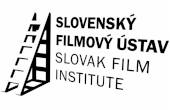 While in 2010 only nine Slovakia-produced or
coproduced films, including one feature film (Flying Cyprian by Marianna Čengel-Solčanská) premiered in cinemas, 11
Slovak movies have been released this year, while another 17 are expected to
premiere between October and December 2011.
While in 2010 only nine Slovakia-produced or
coproduced films, including one feature film (Flying Cyprian by Marianna Čengel-Solčanská) premiered in cinemas, 11
Slovak movies have been released this year, while another 17 are expected to
premiere between October and December 2011.
Moreover, the 2011 crop of Slovak films are achieving success abroad, both in cinema release and at festivals. Among the most international visible releases of 2011 are Martin Šulík's Gypsy, a €1,000,000 Czech-Slovak coproduction from the director's own company Titanic, Slovak Television (www.stv.sk) and In Film (www.infilm.cz), and the feature-length documentary Nicky's Family directed by Matej Mináč and produced by Patrik Pass of Trigon Productions (www.trigon-production.sk).
Notable films that premiered throughout 2011 also include Peter Bebjak's €1,000,000 Apricot Island, produced by D.N.A. Production (www.dnaproduction.sk); Petr Nikolaev's Lidice, a €2,600,000 Czech-Slovak coproduction from Movie (www.filmlidice.cz), Magic Box (www.magicbox.cz), Czech Television (www.ceskatelevize.cz), Vinná Galerie (www.vinnagalerie.cz), Magic Box Slovakia (www.magicboxslovakia.sk) and Slovak Television; Peter Krištúfek's Visible World, coproduced by JMB Film (www.jmbfilm.sk) and Slovak Television and budgeted at €1,200,000; and Stanislav Párnický's Cherry Boy, a €1,400,000 drama from the same coproduction tandem.
The Slovak Audiovisual Fund (www.avf.sk), which succeeded the Culture Ministry's former grant programme Audiovision and started full operation in 2010, continued to support the development, production and distribution of audiovisual works within four different programmes.
To date, 441 out of 897 applications have been accepted and over €9,700,000 has been distributed among the applicants, which amounts to around one-seventh of the total sum applied for (€69,000,000).
In 2011, the largest grant, €370,000, went to Artileria (www.artileria.sk) for the production of Miracle by Juraj Lehotský. ALEF Film and Media Group (www.afm.sk) received €335,000 for the production of Hostage by Juraj Nvota, while JMB Film was granted €320,000 for the development of Live and Let Live (no director announced yet). Major support was also given to Arina (www.arinafilm.sk) for the production of Fair Play by Andrea Sedláčková, to Attack Film (www.attackfilm.sk) for the production of Confidant by Juraj Nvota, and to Jakubisko Film (www.jakubiskofilm.com) for the production of Slavic Epopee by Juraj Jakubisko.
Though box office in the country has traditionally been dominated by US-produced movies, according to the Slovak Union of Film Distributors (www.ufd.sk) the most successful movie of the first half of 2011 was Identity Card, a Czech-Slovak comedy by Ondřej Trojan, coproduced by Total HelpArt (www.tha.cz) and PubRes (www.pubres.sk), which had reached 150,000 admissions by June 2011.
However, it wasn't enough to make up for sluggish box office results in general. Overall cinema attendance fell by 12.8 percent year-on-year in the first half of 2011.
On the other hand, 3D technology is steadily gaining its popularity in Slovakia, with one fourth of movies now being screened in 3D. The very first Slovak film shot in 3D, the ultra-low-budget sci-fi drama Immortalitas by Erik Bošnák leading a team of film school student filmmakers and produced by E.B. Production (www.immortalitasmovie.com), was in the final stages of production by fall of 2011.
The Slovak TV industry remained comparatively stable throughout 2011. In March, Slovakia's transition from analogue television broadcasting to digital technology was launched, and the analogue signal has now been terminated in most areas.
Markíza (www.markiza.sk), operated by Central European Media Enterprises (www.cetv-net.com), has maintained its position as the market leader. However, TV JOJ (www.joj.sk) is far ahead in producing local content: while Markíza offers only two original scripted series, as many as five are currently aired by TV JOJ. Original series are among both channels' most popular programmes.
The state-run Slovak Television currently airs only one self-produced scripted series. It is, however, expected that this number might increase in the future thanks to support from the Audiovisual Fund and special state subsidies aiming at boosting the production of local content by the public broadcaster.



















